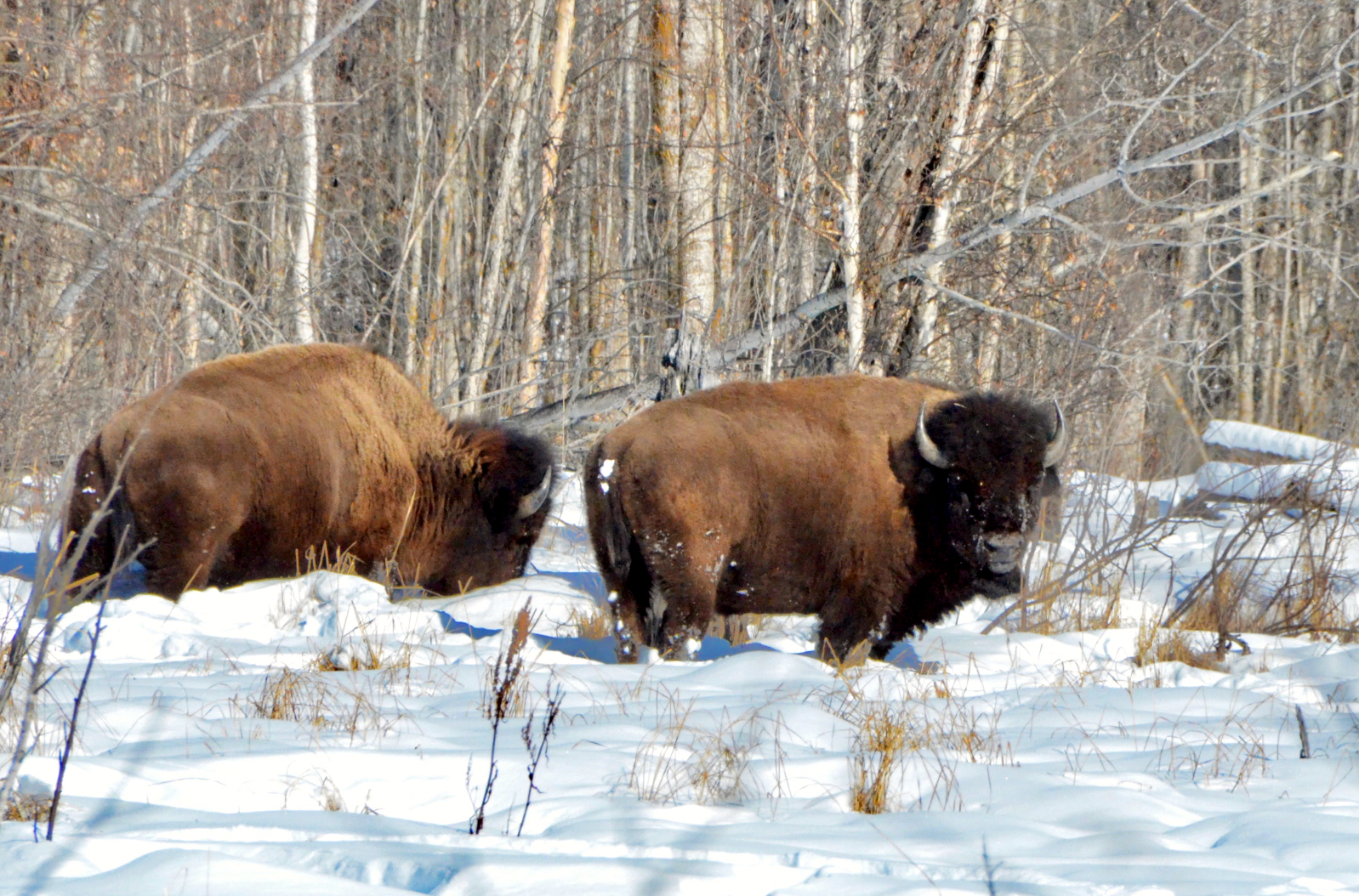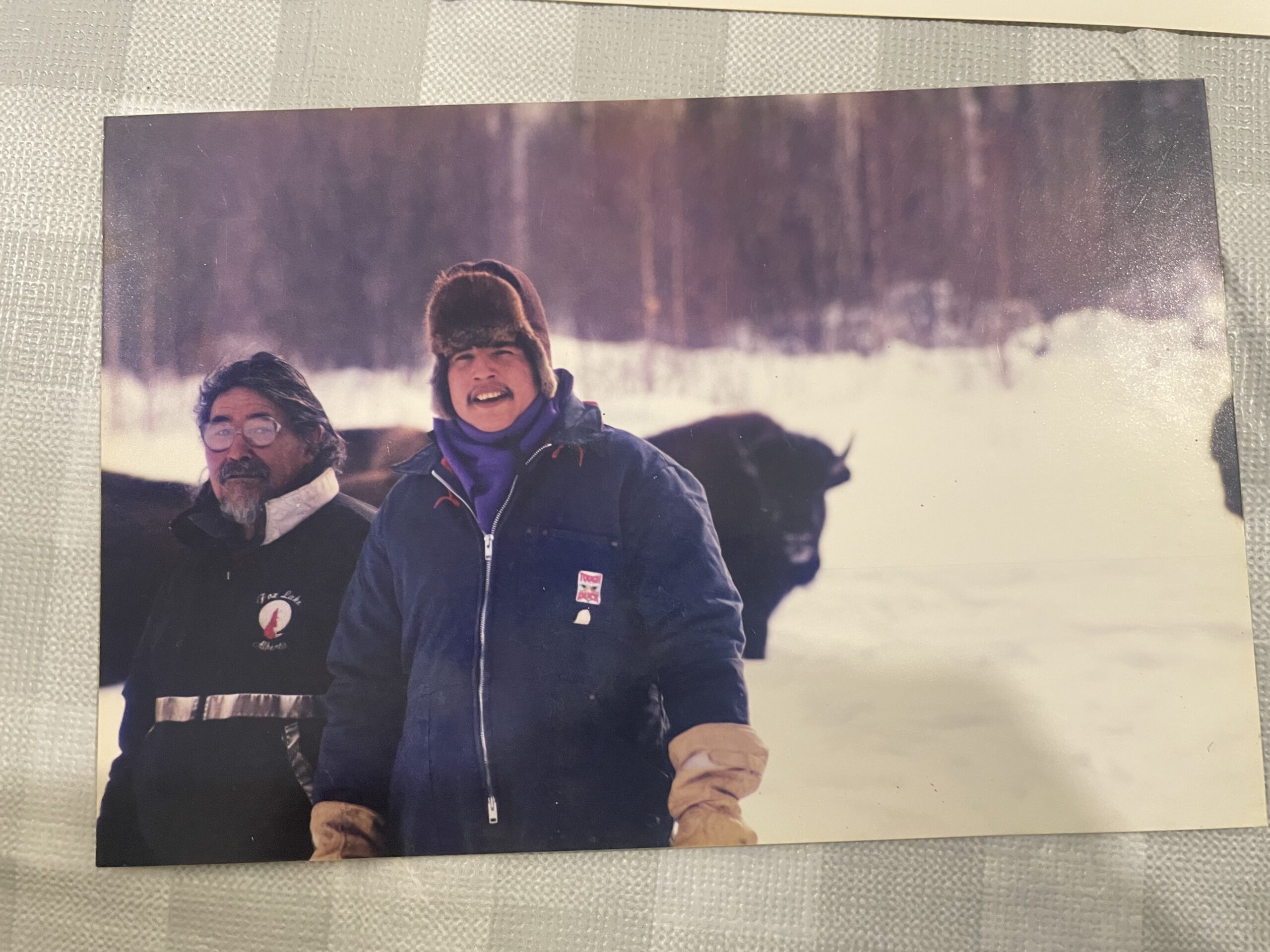
B.C. has a new policy for staking mining claims. Why doesn’t anyone like it?
B.C. previously allowed mineral claims without First Nations consultation. It was court-ordered to fulfill its...
Get the inside scoop on The Narwhal’s environment and climate reporting by signing up for our free newsletter.
At night, deep in the woods of northern Alberta, white images move across the dark screen, the ghostly figures fitting for a buffalo herd that is facing extirpation and now faces the prospect of oil and gas exploration in its range for the first time.
The Wabasca Herd, nestled in an area southwest of Wood Buffalo National Park, is down to six or seven animals, according to area trappers and advocates. That’s down from an estimate of nine animals just under two years ago.
“There’s only one bull left, and what we counted was six cows, one calf, on these wildlife cameras last winter,” Lorne Tallcree, a trapper, said in an interview. “We don’t know what’s left this winter.”
Tallcree is part of a group called ShagowAskee — a group of trappers, Elders and knowledge keepers — which has been advocating to protect the herd, putting pressure on industry, government and their own nations.
Logging in the herd’s range took place last winter, with more expected this year, and now the Little Red River Cree Nation is hosting meetings with Calgary-based Spur Petroleum about its planned exploratory drilling in the area, which is rich with oil deposits.
Tallcree, a member of the nation, says some in the community want to see the jobs that could come with oil and gas, but many are concerned.
He says 26 Elders are opposed to the development.
“They’re scared of what’s coming out, it’s gonna impact the environment, destroy the water, destroy all the medicinal plants they gather,” he said.
The Wabasca herd, along with the nearby Ronald Lake herd, are the only wood bison in Alberta that are living on their native range and which do not have tuberculosis or brucellosis, diseases common to other herds.
Unregulated hunting, habitat pressures and even predation have reduced the herd’s numbers to a point where one bad winter could eliminate it, according to a federal threat assessment.
As part of that threat assessment, between 2011 and 2014, at least 15 of the bison were killed by the provincial government to confirm the herd was disease-free. Members of ShagowAskee, as well as the federal wood bison recovery strategy estimate the number killed was significantly higher, putting it at 24.

Federally, wood bison are considered a threatened species, but the Wabasca herd is stuck in a sort of regulatory limbo as the federal and provincial governments work to identify its critical habitat — a step that would bring protections through the Species At Risk Act.
The herd received a classification that prevented further unregulated hunting in 2021.
A draft conservation agreement between Alberta and the federal government called for more protection for the Ronald Lake herd, including restrictions on mineral exploration — including oil and gas — within its range. No such measures were proposed for the Wabasca herd.
That agreement, drafted in April 2021, has not been signed, according to a spokesperson for Environment and Climate Change Canada.
“Many of the conservation actions in the draft agreement that address imminent threats to wood bison are completed or underway,” Cecelia Parsons said in an email. “The Government of Canada is providing funding support for many of these actions, including funding to Indigenous Peoples to support knowledge gathering, capacity building and participation in conservation actions.”
The offices of Rebecca Schulz, minister of environment and protected areas, and Todd Loewen, minister of parks and forestry, did not acknowledge emailed questions from The Narwhal.
Spur Petroleum held three community meetings for members of the Little Red River Cree Nation at the end of October, but has since cancelled meetings scheduled for December.
In a letter to the company, Elders from ShagowAskee argue there are not sufficient safeguards for water in this area of bogs and wetlands, and drilling it will further fragment the herd’s habitat and leave a “permanent industrial footprint” in the area.

Tallcree said it was his understanding the company could start exploration this winter, if it’s given the go-ahead by chief and council.
It’s unclear whether the cancelled meetings will affect that timeline.
Tallcree and fellow trapper Johnson Alook, also part of ShagowAskee and a member of the Little Red River Cree Nation, both questioned the band government’s motivations, saying members of the land department were trying to push acceptance of Spur’s proposal.
“We get consultation dollars from the Alberta government — for the nation — and I don’t know if it’s right for the lands department to be trying to persuade the membership to vote yes for that, for the development,” Tallcree said.
Neither Spur nor the nation returned requests for comment.
ShagowAskee has pushed for an introduction of new wood bison from Elk Island National Park to bolster the dwindling herd, but those efforts were unsuccessful and now the prospects are dim.
It’s unclear how the herd can survive with only one known male.
Alook says it’s also unclear whether the Little Red River Cree Nation is making the herd a priority.
“If they were, they wouldn’t bring in the oil company,” he said.
Updated Dec. 19, 2024, at 2:02 p.m. MT: An earlier version of this story said the federal government killed at least 15 bison. It was the provincial government. A photo caption also misidentified two men in a photo. They are Paul Tallcree and Lloyd Nanooch.
Get the inside scoop on The Narwhal’s environment and climate reporting by signing up for our free newsletter. On March 17, federal Conservative Leader Pierre Poilievre...
Continue reading
B.C. previously allowed mineral claims without First Nations consultation. It was court-ordered to fulfill its...

British Columbia has vowed to fast-track several mining projects in an effort to blunt the...

Alberta introduced North America’s first industrial carbon tax in 2007. Now an industry email obtained...
